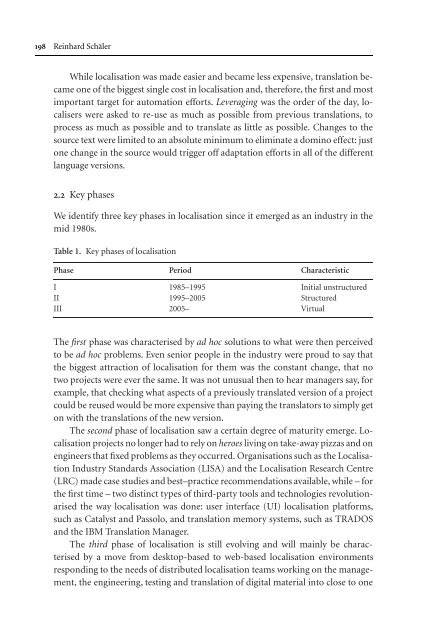Topics in Language Resources for Translation ... - ymerleksi - home
Topics in Language Resources for Translation ... - ymerleksi - home
Topics in Language Resources for Translation ... - ymerleksi - home
- No tags were found...
You also want an ePaper? Increase the reach of your titles
YUMPU automatically turns print PDFs into web optimized ePapers that Google loves.
198 Re<strong>in</strong>hard SchälerWhile localisation was made easier and became less expensive, translation becameone of the biggest s<strong>in</strong>gle cost <strong>in</strong> localisation and, there<strong>for</strong>e, the first and mostimportant target <strong>for</strong> automation ef<strong>for</strong>ts. Leverag<strong>in</strong>g was the order of the day, localiserswere asked to re-use as much as possible from previous translations, toprocess as much as possible and to translate as little as possible. Changes to thesource text were limited to an absolute m<strong>in</strong>imum to elim<strong>in</strong>ate a dom<strong>in</strong>o effect: justone change <strong>in</strong> the source would trigger off adaptation ef<strong>for</strong>ts <strong>in</strong> all of the differentlanguage versions.2.2 Key phasesWe identify three key phases <strong>in</strong> localisation s<strong>in</strong>ce it emerged as an <strong>in</strong>dustry <strong>in</strong> themid 1980s.Table 1. Key phases of localisationPhase Period CharacteristicI 1985–1995 Initial unstructuredII 1995–2005 StructuredIII 2005– VirtualThe first phase was characterised by ad hoc solutions to what were then perceivedto be ad hoc problems. Even senior people <strong>in</strong> the <strong>in</strong>dustry were proud to say thatthe biggest attraction of localisation <strong>for</strong> them was the constant change, that notwo projects were ever the same. It was not unusual then to hear managers say, <strong>for</strong>example, that check<strong>in</strong>g what aspects of a previously translated version of a projectcould be reused would be more expensive than pay<strong>in</strong>g the translators to simply geton with the translations of the new version.The second phase of localisation saw a certa<strong>in</strong> degree of maturity emerge. Localisationprojects no longer had to rely on heroes liv<strong>in</strong>g on take-away pizzas and oneng<strong>in</strong>eers that fixed problems as they occurred. Organisations such as the LocalisationIndustry Standards Association (LISA) and the Localisation Research Centre(LRC) made case studies and best–practice recommendations available, while – <strong>for</strong>thefirsttime–twodist<strong>in</strong>cttypesofthird-partytoolsandtechnologiesrevolutionarisedthe way localisation was done: user <strong>in</strong>terface (UI) localisation plat<strong>for</strong>ms,such as Catalyst and Passolo, and translation memory systems, such as TRADOSand the IBM <strong>Translation</strong> Manager.The third phase of localisation is still evolv<strong>in</strong>g and will ma<strong>in</strong>ly be characterisedby a move from desktop-based to web-based localisation environmentsrespond<strong>in</strong>g to the needs of distributed localisation teams work<strong>in</strong>g on the management,the eng<strong>in</strong>eer<strong>in</strong>g, test<strong>in</strong>g and translation of digital material <strong>in</strong>to close to one
















